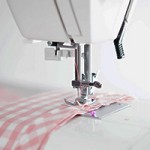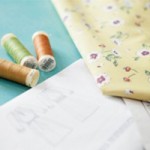In this online course you can work through the modules and lessons at your own pace. Re-watch modules as needed and dip in and out of whenever you need a little reminder.
If you like our tutorial please do drop us a line at hello@bobbinsewingschool.com or better still leave us a review on Google or Facebook. Thank you
Archive | Beginners
How to Use your Overlocker
The ever scary overlocker, if you own one and feel its missing its potential, bring it along to this class and we will spend some time discussing and practicing the different stitches and techniques available on your machine. We will create samples that you can keep to refer too in the future.
Class level – Intermediate, you will have sewn other easy to make garments and have good basic sewing knowledge. Have access to and be able to bring your own overlocker to the class along with the manual for the machine.
The topics we aim to cover are:
We aim to cover the points on the list below. Depending on how many questions you have, we may not get a chance to cover everything – please let us know if there is something specific you really want help with before you leave if we don’t cover it in the class.
We aim to teach you the skills you will need to improve your overlocker use.
All fabrics are included for the class
Specifically you will learn;
- Overlocker techniques
- Stitches and how to change them
- Tension issues
- Attaching a continuous neck band
- Working with different fabrics
- Differential feed
- Changing needles
- The Overlocker rolled hem
What you need to bring to the class:
- An Overlocker and any accessories you have
- Your overlocker manual (important)
Maximum class size 4
Tutor
Aly Warner
How To Use A Sewing Machine
 A class for absolute beginners and a fantastic course to get you on your way – learn how to thread and operate a sewing machine confidently. Take your samples home with you and have everything you need to refer to in the future. This is one of our favourite sessions as it’s like teaching someone to drive, as soon as you get it, you’re on your way. Scheduled classes are shown at the bottom of the page.
A class for absolute beginners and a fantastic course to get you on your way – learn how to thread and operate a sewing machine confidently. Take your samples home with you and have everything you need to refer to in the future. This is one of our favourite sessions as it’s like teaching someone to drive, as soon as you get it, you’re on your way. Scheduled classes are shown at the bottom of the page.
Class level- Total beginner / Refresher
What we will cover in this session
We aim to cover the list below, but depending on how many questions you may have we may not get a chance to cover everything – please let us know if there is something specific you really want help with before you leave which we haven’t covered.
How to thread the machine
How to wind on the bobbin and insert the bobbin
Stitching straight, curves and corners
ZigZag stitches and stretch stitches
Understanding tension and problem solving tension issues
Importance of a completing the stitch cycle
Reversing
Importance of steering the fabric
Machine feet and how to use them
Have a go at creating seams a rolled hem and applique
Understanding which needles to use with different fabrics
Basic troubleshooting
What you need to bring with you
Nothing! All is provided, but if you have one you may wish to bring your own machine to get the best from the class
Tutor
Aly Warner
| Date/Time | Class | Cost | Spaces |
|---|---|---|---|
|
26/07/2024 10:00 am - 1:00 pm |
How to Use a Sewing machine
The Old Veterinary Surgery, Stockbridge Hampshire |
£45.00 | 3 |
Beginner’s Sewing Masterclass
 This is great class if you know a little sewing – so long as you can use a machine you will be able to handle this class no problem. We will show you techniques that you will use time and time again. Knowing a few simple techniques will help you go a long way to complete all sorts of projects whether used in craft, dressmaking of furnishings. You will leave with a folder of samples to refer to in the future.
This is great class if you know a little sewing – so long as you can use a machine you will be able to handle this class no problem. We will show you techniques that you will use time and time again. Knowing a few simple techniques will help you go a long way to complete all sorts of projects whether used in craft, dressmaking of furnishings. You will leave with a folder of samples to refer to in the future.
Class level – Beginner
What we will cover in the session
We aim to cover the following in the lessons
Convex curves
Concave curves
Darts
French Seams
Facings
Hems
Buttonholes
Simple zip
Piping
What you need to bring with you
All materials are provided for this class
Tutor
Aly Warner
Beginner’s Patchwork
 Have you often looked at quilts on line and in books and wondered where to start? Well, this is the class for you. In this one day workshop we take the mystery out of ‘modern’ patchwork using a sewing machine and hopefully kick start your creative side to produce easy but effective patchwork items (quilts/table runners/cushions) for all your friends and family. A full day packed with tips and inspiration that will have you going home with a small project and big ideas.
Have you often looked at quilts on line and in books and wondered where to start? Well, this is the class for you. In this one day workshop we take the mystery out of ‘modern’ patchwork using a sewing machine and hopefully kick start your creative side to produce easy but effective patchwork items (quilts/table runners/cushions) for all your friends and family. A full day packed with tips and inspiration that will have you going home with a small project and big ideas.The topics we aim to cover in this lesson
Fabric Terminology
Handling your fabric
Rotary Cutting – Equipment and use
Basic Sewing Machine Use
Achieving an accurate 1/4” seam
Pressing
Nine Patch Blocks
Easy triangle Blocks
Using the blocks you create we will make a simple table runner
Materials Needed:
We have sewing machines for you to use but if you would like to bring your own please advise us at the time of booking. If bringing your own machine, a 1/4” foot would be useful, but not essential. You will also need to bring along 4 coordinating cotton fabrics these will need to be 50cm X 60cm (fat quarters) and a thread in a colour that blends with all your fabrics.
We will supply Batting (wadding) to complete your table runner
Tutor
Aly Warner

Sumptuous Piped Cushion Masterclass

Create gorgeous professional-looking cushion covers yourself. We’ll show how to make a piped cushion with a zip fastening. A lovely addition to your home and also ot give as gifts.
What we will cover in the session
We will cover the following in the session to create your cushion cover
Correct measuring of cushion pad to get a plump finish
Marking fabric and cutting
How to create professional corners
How to insert piping
How to insert a zip
What you need to bring to make your cushions
We aim to make a standard cushion with piping . Please don’t spend a lot of money on fabric, a simple calico will suffice if you want to gain confidence before unleashing yourself on the expensive stuff!
A square or rectangle pillow – any size
Enough fabric (preferably cotton medium weight) to make a front and back with seam allowances
Thread to match your fabric
Piping cord enough to go around the cushion pad
Pre cut bias binding tape 2.5 cm folded (approx 5 cm wide when pressed open) in a contrast colour enough to go around your cushion pad
A zip the width or more of your cushion in the colour of your bias binding
Cushions starter kit
If you don’t have the time to get everything you need for the class, you can buy one of our starter kits for £15 on the day. You’ll have everything you need to make a 16’’ square cushion . The kit includes fabric, piping, zip and a standard cushion pad.
Tutor
Mary
